
The air was thick with the sound of mosquitos buzzing at Engineer Creek, our chosen campsite for the night in the Yukon. It was Canada Day – July 1, 2016. We’d driven close to ten hours to this boggy place to lie our heads from Inuvik, the administrative center of Canada’s Western Arctic. It was here at our starting point, in the 1950s, that the Canadian government decided to plop down a town on the tundra in order to govern the north. The Dempster Highway, the only way out of Inuvik, would come in the decades to follow, linking Inuvik to Canada’s south. Ottawa pretty much dreamed up the town and the 737-kilometer long highway as ways to enhance sovereignty and access northern resources. In effect, Inuvik and the Dempster Highway are symbols of the Canadian state. So what better way to experience Canada Day than to drive along a highway that permanently etched the Canadian state into a territory long inhabited by the Gwich’in people, grizzly bears, wolverines, and moose?
The hours passed as the seven of us plus one fluffy dog increased our distance from Inuvik along the highway. The trees, stunted from growing in unstable, shifting permafrost, became stronger and sturdier as we made our way south. After what must have been about 4 or 5 hours, we stopped in Eagle Plains for a bite to eat and some gas. Everyone has to stop here, since it’s the only gas station around for hundreds of miles.
This being Canada Day, the restaurant’s television was airing a feature on what Canadians thought Canada represented. People of all ethnicities and nationalities, from a Yellowstone Aboriginal woman to a recent arrival to Toronto from Syria, cheerfully said things like “Tolerance!” and “Opportunity!” This segment was followed by a feature that found random Canadians on the street in New York City, not too far from Trump Tower, to ask them what they thought about Donald Trump, who had yet to be elected. Canadians were mostly perplexed and horrified, as they remain today. Canada’s identity, it can be said, in no small part comes from trying to distinguish itself from its southern, more orange neighbor – especially on Canada Day.

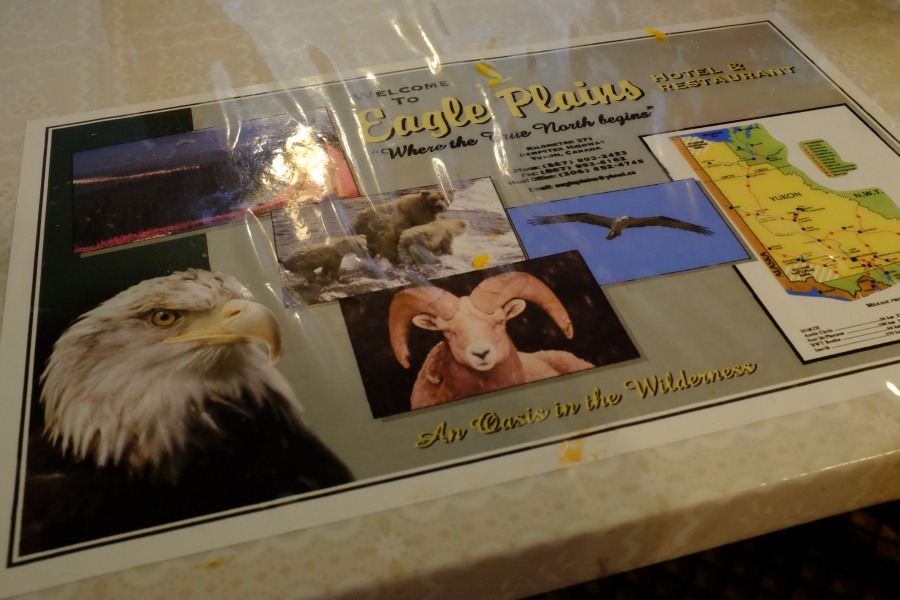
As we piled back into the aptly named Yukon SUV and drove south, the mountains reached higher and higher into the sky. The windshield grew thick with the carcasses of mosquitos. We were in the Yukon. “Larger than life” is the territory’s motto, but a woman I met once from Whitehorse couldn’t stand it. Why? Because it made the territory seem vacant and empty, even though First Nations people had lived there for tens of thousands of years. The Bluefish Caves, the oldest known archaeological site in North America, are in the Yukon. Earlier this year, scientists published a paper in the prestigious PLOS One journal estimating human occupation in the Bluefish Caves since 24,000 years ago.
In other words, the Dempster Highway, which opened in the 1970s, has existed for 0.002% of the time since humans are thought to have inhabited the Yukon. But yet, it’s become a symbol of the Canadian North – much more so than, say, the Bluefish Caves. The gravel road has left an indelible imprint on the environmental and cultural landscape of the north. As the Canadian state penetrated north thanks to the highway, so did Red Rose tea, all-dressed and ketchup-flavored potato chips, skidoos (a Canadian invention), and American RVs, which slogged all the way up to Inuvik. (Tim Horton’s has yet to open up a shop in Inuvik, much to the chagrin of many residents). The artificial settlement even attracted Queen Elizabeth II to visit in 1970 on the Centennial of the Northwest Territories. A hundred years prior, Hudson’s Bay Company had transferred the land to Canada. A country born of a company.

As an American, celebrating Canada Day in the Yukon felt both familiar and foreign. With my newfound Canadian friends, who were so welcoming and generous, we made s’mores by the side of the Ogilvie River. This seemed pretty much par for the course for summer in the USA, but then I noticed how the back of the graham cracker box had instructions for “biscuits-sandwich à la guimauve.” This is what Quebeckers call the gooey North American treat, as if eating a s’more wasn’t enough of a mouthful. As the night progressed, instead of fireworks lighting up the night, a rainbow unfurled across a soft blue sky around 1:30 am. It was never going to get dark, because we were way up north.
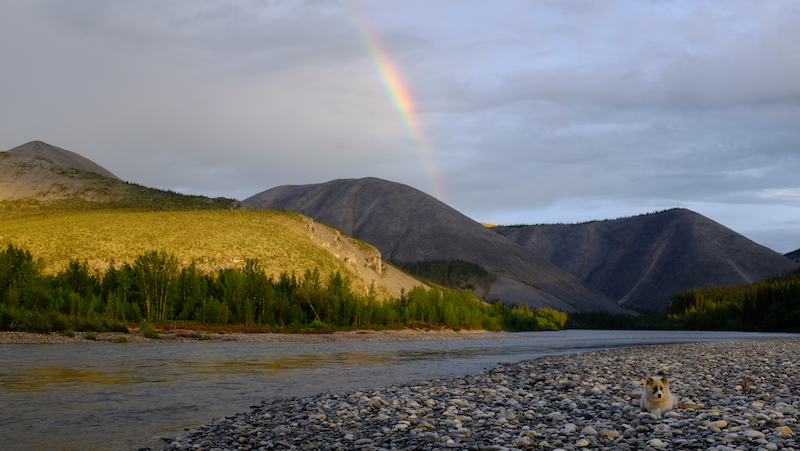
We spent the next few days hiking and looking for wildlife in the incredible Tombstone Territorial Park. Just as the Northwest Territories traces its origins to a company, the park paradoxically traces its origins to a highway. The Management Plan for the park from 2009 states,
“In 1974, the federal government identified a park reserve on the Department of Indian Affairs and Northern Development land maps. The reserve was designed to “protect” the view of Tombstone Mountain from the newly built Dempster Highway.”
Nature was initially preserved, in other words, for the pleasure of tourists and travelers driving by rather than for the benefit of the Tr’ondëk Hwëch’in who traditionally resided in the area or for the flora and fauna that live there. The park’s location was picked from the top down by state officials looking at a map rather than wandering out in the land. There’s no doubting that the view was a stunner, especially with the sunrise and sunset being only about an hour apart. But there’s something empty feeling that it was chosen based on the automobile’s gaze.
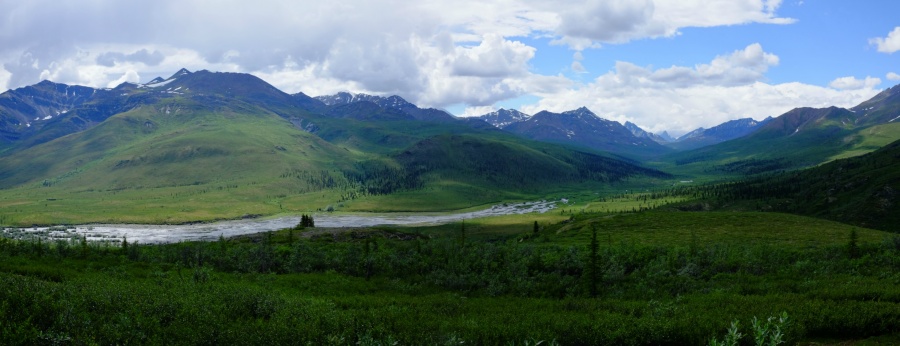
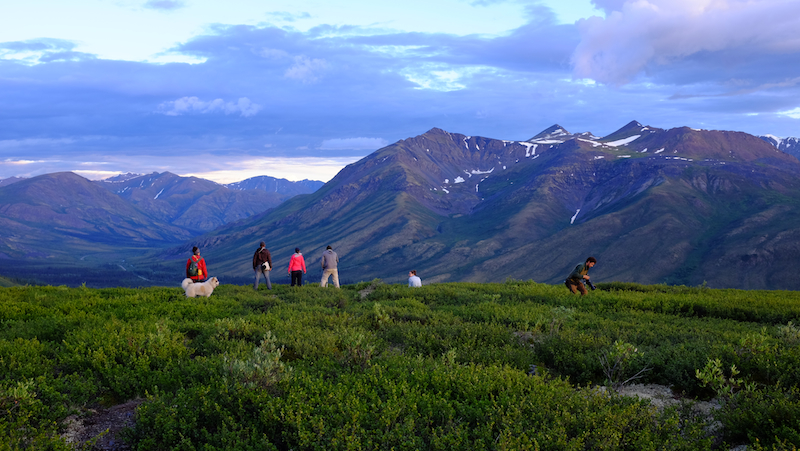
Thinking back on Canada Day, the country has made huge strides since the 1970s, when the Dempster Highway was put in, when the park reserve was created, and when the Queen visited the Northwest Territories. Some things are still the same. The Dempster Highway is being extended to Tuktoyaktuk, on the Arctic Ocean, and will open later this year if all goes according to plan. A few days ago, Prince Charles and the Duchess of Cambridge visited Nunavut to commemorate Canada’s 150 Centenary, drinking tea with elders in Iqaluit.
But in a more progressive direction, Tombstone Territorial Park itself was created as part of the 2004 land claims settlement with the Tr’ondëk Hwëch’in, who co-manage the park with the Yukon Territorial Government. Further north, two Inuvialuit companies are building the Dempster Highway extension. And recognition of the value of traditional knowledge across Canada is gradually growing.
I came across a quote by Tr’ondëk Hwëch’in elder Percy Henry in an autobiography by Canadian Olympian Clara Hughes. He stated of the Tombstone Range:
“You have everything you want there. There’s all kinds of berries, fish and little animals that live in that country. I was born and raised in that country.”
“That country” refers to Tombstone, not Canada. That country, the land, will always be there in some form or another. While Canada Day this year celebrates the country’s 150th anniversary, it’s worth asking what Canada will be like in another one and a half centuries. Will the Dempster Highway still exist, given the rapidity of climate change? Will graham cracker boxes in Canada still come with s’mores recipes in English and French, or will Quebec finally split off? Answers to these questions are yet unknown, but in any case, at her current rate, Queen Elizabeth II will likely still be the head of state.
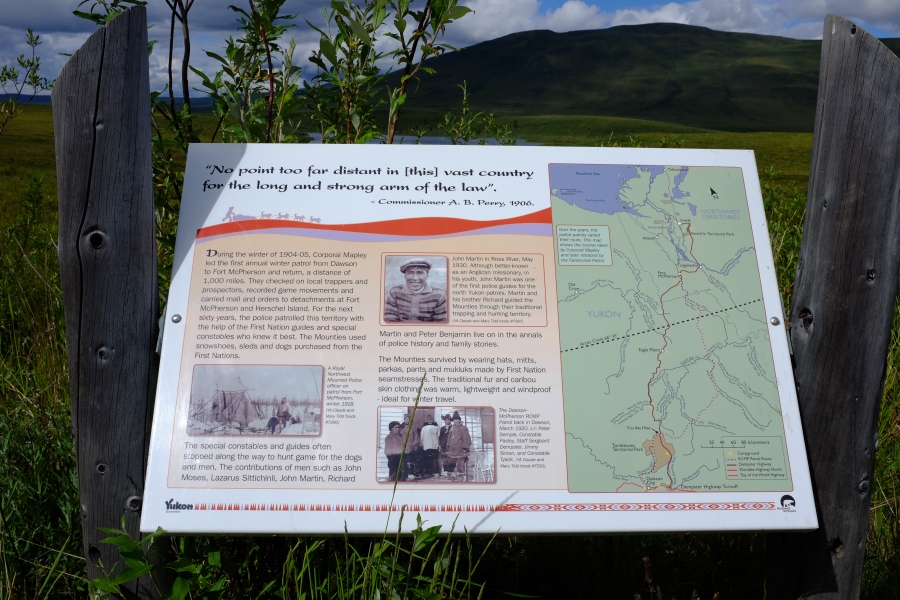
In 2167, Canada will also probably still be viewing the U.S. with equal parts obsession, bemusement, and horror, assuming its unruly southern neighbor does not self-implode in the next three and a half years to 150 years. Driving back from Tombstone to Inuvik, we made the prerequisite stop at Eagle Plains. In the restaurant, CBC News played on the television. It felt like Groundhog Day in a way, as it was now July 4 rather than July 1. The same, but different. Independence Day rather than Canada Day. Just like the difference between Canadian and American Thanksgiving.
Not having slept the night before, I ingested with bleary eyes the statistics that flashed on the screen. Apparently, Americans eat 150 million hot dogs on the Fourth of July. That’s 150 million chien-chauds, hot-dogs, or steamés, if you’re French Canadian.

Hi Mia… As a one-time Yukoner I enjoyed reading this post (and learned a thing or two about the creation of Tombstone park!). Would it be OK if I reposted it at Arctic Deeply, with the usual credit and link back to your blog?
I’ll also be facing the usual nuisance of trying to get bigger images than what’s on the blog. Looks like most the pictures are shot by yourself – do you have full-size versions you’d be able to email over?
All the best,
John
Excuse me for commenting, Mia. I follow the blog but don’t get a chance to read from it as often as I would like. But I chanced upon a rare spare few minutes the other day, just as this was posted. What I chanced upon was a topical, relevant, and beautifully written piece that shows your great regard for the region and showcases the greater Arctic. This is good work.
Hi P Bobby,
Thanks for reading and for your kind words. I appreciate it.
By the way, I wrote quite a few articles for Nunatsiaq News about the threat of a looming gravel shortage back in the day, so your more recent piece certainly resonates with my experiences…
http://www.nunatsiaqonline.ca/stories/article/last_minute_deal_averts_gravel_crisis/
Great piece, John. I feel it’s the Arctic natural resource nobody’s talking about – mostly because there isn’t much interest in Arctic gravel beyond the region.